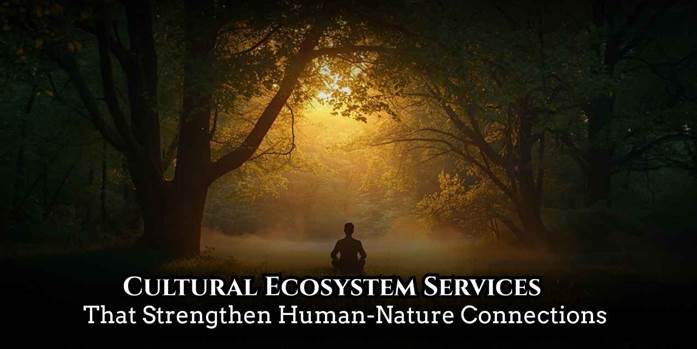Our environment offers far more than just clean air and water it also nurtures our emotions, creativity, and traditions. Cultural ecosystem services refer to the non-material benefits people gain from nature, such as inspiration, recreation, and a sense of belonging. From peaceful landscapes that inspire art to natural spaces that foster community gatherings, these services shape our cultural identity and emotional well-being.
In this article, we’ll explore seven remarkable examples that show how nature supports human connection, creativity, and spiritual growth. Whether through ecotourism, environmental education, or heritage conservation, these interactions remind us that protecting nature also means preserving the cultural values that define us.

Understanding Cultural Ecosystem Services
Cultural ecosystem services are the non-material benefits people receive from nature that contribute to their emotional, intellectual, and spiritual well-being. Unlike provisioning or regulating services, which provide food or clean air, these focus on how ecosystems inspire art, traditions, education, and recreation. They form the emotional and cultural bridge between humans and the natural world.
Background and Evolution of the Concept
The idea of cultural ecosystem services gained attention in the early 2000s through the Millennium Ecosystem Assessment, which categorized ecosystem benefits into four main types: provisioning, regulating, supporting, and cultural. This framework helped highlight the importance of non-material values those that affect happiness, identity, and community. Over time, researchers and conservationists have realized that emotional connections to nature are key drivers of sustainable behavior and environmental protection.
Importance of Cultural Ecosystem Services
Cultural ecosystem services are vital for maintaining a meaningful relationship between people and nature. They provide a foundation for community identity, support mental health, and promote sustainable lifestyles.
Some of the most important contributions include:
• Encouraging creativity and artistic inspiration
• Strengthening social ties and community traditions
• Supporting spiritual and religious practices
• Enhancing mental relaxation and emotional well-being
• Promoting environmental awareness through education and tourism
When societies recognize these values, they are more likely to care for natural spaces and protect biodiversity for future generations.
Benefits of Cultural Ecosystem Services
Cultural ecosystem services play a powerful role in both individual and collective well-being. They:
• Offer recreational opportunities that improve quality of life
• Support cultural identity and heritage conservation
• Provide educational experiences for schools and communities
• Inspire innovations in art, music, and literature
• Boost the local economy through sustainable tourism
By preserving natural areas that deliver these benefits, communities can strengthen both their ecological and cultural resilience.
Challenges in Preserving Cultural Ecosystem Services
Despite their value, cultural ecosystem services face numerous challenges:
• Urbanization: Rapid city expansion reduces access to natural landscapes, disconnecting people from nature.
• Loss of traditional knowledge: As communities modernize, traditional practices tied to natural environments may fade.
• Tourism pressure: Overuse of natural sites can lead to degradation and cultural disruption.
• Climate change: Environmental changes threaten sacred sites, heritage areas, and the species that hold cultural meaning.
Addressing these challenges requires awareness, education, and sustainable management of cultural landscapes.
Top 7 Examples of Cultural Ecosystem Services That Strengthen Human-Nature Connections
1. Spiritual and Religious Value
Many cultures see nature as sacred and central to spiritual beliefs. Forests, rivers, and mountains often hold symbolic meaning in various religions. For example, the Ganges River in India is revered as holy, drawing millions of pilgrims annually. Such sacred connections show how ecosystems can shape spiritual identity and moral responsibility.
2. Aesthetic Inspiration
Natural beauty has inspired countless artists, writers, and musicians. Landscapes like mountains, forests, and oceans serve as creative muses, encouraging artistic expression. From Van Gogh’s “Starry Night” to poetry inspired by the sea, the aesthetic value of nature continues to shape global culture and art.
3. Recreation and Ecotourism
Outdoor activities such as hiking, birdwatching, and camping allow people to enjoy nature while promoting conservation. Ecotourism also provides economic benefits to local communities. Well-managed tourism projects, like those in national parks, encourage both enjoyment and protection of ecosystems.
4. Educational Opportunities
Natural environments serve as living classrooms where people learn about ecology, geography, and sustainability. Schools and universities use nature-based education to teach respect for biodiversity. Programs like environmental field trips and conservation camps foster awareness and curiosity among young learners.
5. Cultural Heritage and Traditions
Many cultural practices are tied to natural elements such as rivers, forests, and animals. Indigenous communities, for instance, hold ceremonies and festivals celebrating the harvest or seasonal changes. These traditions keep historical knowledge alive and pass down ecological wisdom through generations.
6. Social and Community Connections
Nature often brings people together. Community gardens, parks, and beaches act as gathering spaces that promote unity and cooperation. Events like tree-planting days or coastal cleanups strengthen social bonds while encouraging environmental responsibility.
7. Health and Well-Being
Exposure to nature reduces stress, boosts mood, and enhances overall mental health. Walking through green spaces or spending time outdoors improves focus and relaxation. Studies have shown that people who regularly engage with natural settings experience greater happiness and emotional stability.
The Broader Impact on Human-Nature Relationships
Cultural ecosystem services remind us that nature’s value goes beyond material gain. These services create emotional, educational, and social ties that help people understand their role within the environment. By appreciating these non-material benefits, societies can promote sustainability while nurturing human well-being.
Protecting these connections ensures that future generations continue to experience nature’s beauty and meaning. Through responsible tourism, environmental education, and cultural preservation, humans can sustain both biodiversity and the cultural bonds that define our shared world.

Conclusion
Cultural ecosystem services highlight how deeply human life is connected to nature through art, spirituality, learning, and shared experiences. They remind us that natural spaces are not just physical environments but also sources of emotional and cultural enrichment. Preserving these values strengthens our bond with the planet while promoting mental well-being and community harmony. By understanding and protecting cultural ecosystem services, we ensure that future generations can continue to draw inspiration, wisdom, and joy from the world around them. Explore further to appreciate how culture and nature truly coexist.